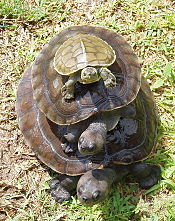Beale's eyed turtle
| Beale's eyed turtle | |
|---|---|
| Scientific classification | |
| Domain: | Eukaryota |
| Kingdom: | Animalia |
| Phylum: | Chordata |
| Class: | Reptilia |
| Order: | Testudines |
| Suborder: | Cryptodira |
| Superfamily: | Testudinoidea |
| Family: | Geoemydidae |
| Genus: | Sacalia |
| Species: | S. bealei
|
| Binomial name | |
| Sacalia bealei (Gray, 1831)
| |
| Synonyms[3] | |
| |
Beale's eyed turtle (Sacalia bealei) is a species of turtle in the family Geoemydidae (formerly Bataguridae). The species is endemic to China.
Description
[edit]S. bealei has a yellowish-brown, smooth, rather depressed carapace spotted with black, and it has an olive-green head. Another form of this species has a brown carapace. In both forms, there are two pairs of black-centered ocelli on the back of the head which is peppered with black spots. This is a turtle of moderate size and will grow up to a maximum straight-line carapace length of 18 cm (7 inches).[4]
Habitat
[edit]A nocturnal species, S. bealei lives in mountain streams at all elevations, but with a preference for heavily forest-covered streams with many large stones so as to provide shelter.[4]
Diet
[edit]S. bealei feeds on crayfish and worms, and accepts meat in captivity.[4]
Behavior
[edit]A timid and nervous species, S. bealei will scramble and flail wildly with its claws when handled.[4]
Reproduction
[edit]S. bealei is reported to lay 6 eggs at a time.[4] The nests are often half-buried by leaves and soil, and the entire nesting process may take up to 165 minutes.[5]
Common names
[edit]S. bealei is sometimes called Beale's four-eyed turtle, though that is not an ideal common name due to the possibility of confusion with the four-eyed turtle proper (S. quadriocellata).
Etymology
[edit]The specific name, bealei, is in honor of Thomas Beale, a Scottish naturalist and merchant in China.[6]
Geographic range
[edit]S. bealei occurs throughout the provinces of central and Southern China. It is considered very rare in Hong Kong.[4]
Conservation status
[edit]Listed as endangered by the IUCN,[1] these turtles are hunted for use in folk medicine.[7] However, the Hong Kong Reptile and Amphibian Society has found that this species is sold in pet shops in Hong Kong, with the specimens almost certainly locally caught, even though the species is locally protected.[8] It is also threatened by habitat loss. The fact that it lays only one clutch per year and that the eggs are often heavily infested with ants makes conservation efforts even harder for this already very rare species.[5][9]
References
[edit]- ^ a b Asian Turtle Trade Working Group (2000). "Sacalia bealei (errata version published in 2016). The IUCN Red List of Threatened Species 2020: https://dx.doi.org/10.2305/IUCN.UK.2000.RLTS.T19796A9016239.en. Downloaded on 21 June 2021.
- ^ "Appendices | CITES". cites.org. Retrieved 2022-01-14.
- ^ Fritz, Uwe; Havaš, Peter (2007). "Checklist of Chelonians of the World". Vertebrate Zoology. 57 (2): 247. doi:10.3897/vz.57.e30895. ISSN 1864-5755.
- ^ a b c d e f Karsen, Stephen J.; Wai-Ming, Lau; Bogadek, Anthony (1998). Hong Kong Amphibians and Reptiles. Hong Kong: Provisional Urban Council. p. 75. ISBN 962-7849-05-7.
- ^ a b Lin, Liu; Hu, Qingru; Fong, Jonathan J.; Yang, Jiangbo; Chen, Zhongdong; Zhou, Feiyu; Wang, Jichao; Xiao, Fanrong; Shi, Haitao (2018). "Reproductive ecology of the endangered Beal's-eyed turtle, Sacalia bealei ". PeerJ. 6: e4997. doi:10.7717/peerj.4997. ISSN 2167-8359. PMC 6018645. PMID 29963334.
- ^ Beolens, Bo; Watkins, Michael; Grayson, Michael. (2011). The Eponym Dictionary of Reptiles. Baltimore: Johns Hopkins University Press. xiii + 296 pp. ISBN 978-1-4214-0135-5. (Sacalia bealei, p. 20).
- ^ da Nóbrega Alves et al. (2008)
- ^ "香港爬蟲協會 - 香港受保護野生動物". www.hkras.org. Retrieved 2020-11-07.
- ^ "Beal's Four Eyed Turtle – Sacalia bealei ". HongKongSnakeID.com. Retrieved 2020-11-21.
Further reading
[edit]- Boulenger, George Albert. (1889). Catalogue of the Chelonians, Rhynchocephalians, and Crocodiles in the British Museum (Natural History). New Edition. London: Trustees of the British Museum (Natural History). (Taylor and Francis, printers). x + 311 pp. + Plates I- VI. ("Clemmys bealii [sic]", p. 107).
- da Nóbrega Alves, Rômulo Romeu; da Silva Vieira, Washington Luiz; Gomes Santana, Gindomar. (2008): "Reptiles used in traditional folk medicine: conservation implications". Biodiversity and Conservation 17 (8): 2037–2049. doi:10.1007/s10531-007-9305-0 (HTML abstract, PDF first page)
- Gray, John Edward. (1831). Synopsis Reptilium; or Short Descriptions of the Species of Reptiles. Part I.—Cataphracta. Tortoises, Crocodiles, and Enaliosaurians. London: Treuttel, Wurtz, and Co. viii + 85 pp. ("Cistuda Bealei ", p. 71).


